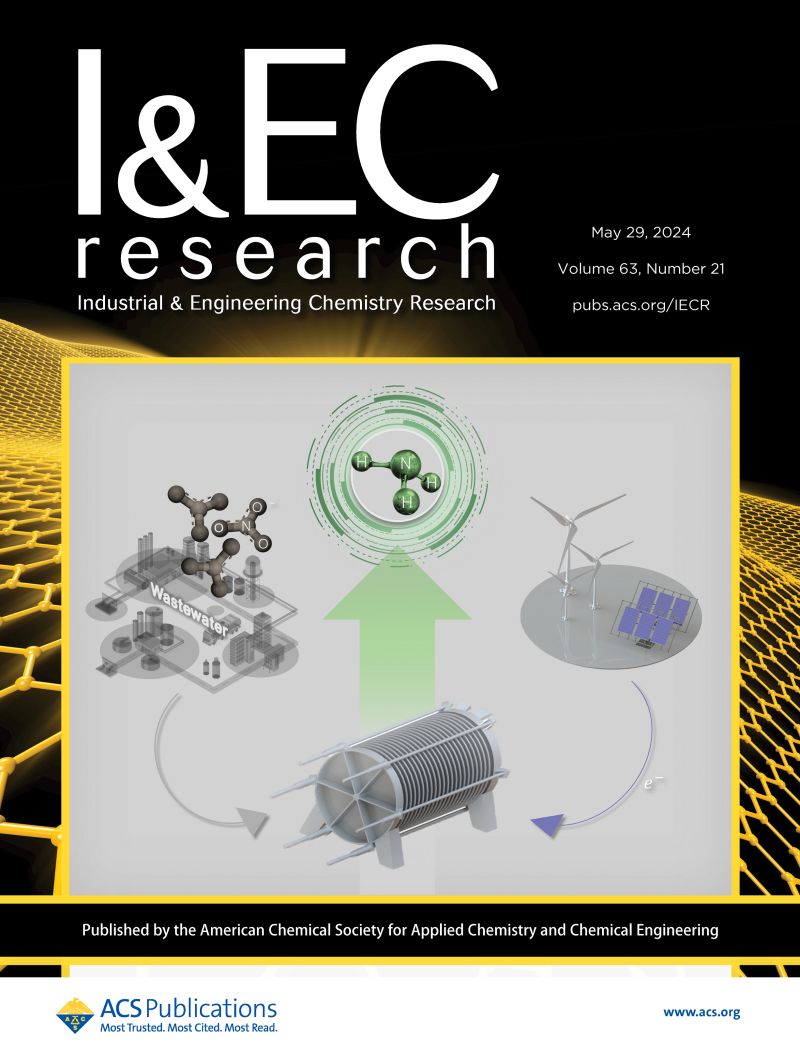燃烧后CO2捕集过程中2-(乙胺)乙醇水溶液的热降解机理
IF 3.8
3区 工程技术
Q2 ENGINEERING, CHEMICAL
引用次数: 0
摘要
胺基水溶液被认为是一种很有前途的吸收剂,用于燃烧后的二氧化碳捕获。新型胺2-(乙胺)乙醇(EMEA)与基准胺单乙醇胺(MEA)相比具有更好的吸附和解吸性能,具有更大的CO2捕获潜力。然而,由于缺乏对EMEA热降解的深入研究,它能否在工业CO2捕集过程中长期稳定运行仍不确定。因此,采用综合计算研究与实验相结合的方法,研究了EMEA在CO2作用下的热降解问题。结果表明,在热降解过程中生成了关键反应中间体3-乙基-1,3-恶唑烷-2-酮(EOZD)。EOZD可以通过质子化EMEA (EMEAH+)和(2-羟乙基)氨基甲酸乙酯(EMEACOO -)的离子对反应形成,也可以通过水催化(2-羟乙基)氨基甲酸乙酯(EMEACOOH)的自环脱水反应形成。此外,EOZD可以通过emah +与质子化2-二乙基氨基乙醇(DEEAH+)的独特反应形成,DEEAH+由emah +和EMEA的甲基化和去甲基化反应形成。形成的EOZD进一步转化为稳定的产物N,N-乙基-N′-(2-羟乙基)乙二胺(DEHEED)。揭示了EMEA的热降解机理,为进一步了解其他结构类似的仲胺的热稳定性奠定了基础。通过比较EMEA和MEA的降解,发现EMEA由于存在一个乙基作为供电子取代基,更容易发生热降解。这一见解可以为调节和减少胺的降解以及开发更热稳定的胺基溶剂用于CO2捕获提供理论指导。本文章由计算机程序翻译,如有差异,请以英文原文为准。

Thermal Degradation Mechanism of 2-(Ethylamino) Ethanol Aqueous Solution within a Postcombustion CO2 Capture Process
An amine-based aqueous solution is considered a promising absorbent for postcombustion CO2 capture. The novel amine 2-(ethylamino) ethanol (EMEA) presents better absorption and desorption performance compared to the benchmark amine monoethanolamine (MEA), giving it more potential for CO2 capture. However, with the lack of in-depth research on the thermal degradation of EMEA, it remains uncertain whether it can operate stably over the long term in industrial CO2 capture processes. Therefore, a comprehensive computational study combined with experiments was employed to figure out the thermal degradation of EMEA with CO2. The results indicate that the key reaction intermediate 3-ethyl-1,3-oxazolidin-2-one (EOZD) is formed in the thermal degradation process. EOZD can be formed through the ion pair reactions of protonated EMEA (EMEAH+) and ethyl (2-hydroxyethyl) carbamate (EMEACOO–) or through the water-catalyzed self-cyclization–dehydration reaction of ethyl (2-hydroxyethyl) carbamic acid (EMEACOOH). Additionally, EOZD can be formed through a unique reaction between EMEAH+ and protonated 2-diethylaminoethanol (DEEAH+), with DEEAH+ being formed by the methylation and demethylation reactions of EMEAH+ and EMEA. Then, the formed EOZD can be further transformed into the stable product N,N-ethyl-N′-(2-hydroxyethyl) ethylenediamine (DEHEED). The revealed thermal degradation mechanism of EMEA serves as a foundation for understanding the thermal stability of other structurally analogous secondary amines. Through comparison of EMEA and MEA degradation, it was found that EMEA is more prone to thermal degradation due to the existence of an ethyl group as an electron-donating substituent. This insight can offer theoretical guidance for regulating and reducing amine degradation and the development of more thermally stable amine-based solvents for CO2 capture.
求助全文
通过发布文献求助,成功后即可免费获取论文全文。
去求助
来源期刊

Industrial & Engineering Chemistry Research
工程技术-工程:化工
CiteScore
7.40
自引率
7.10%
发文量
1467
审稿时长
2.8 months
期刊介绍:
ndustrial & Engineering Chemistry, with variations in title and format, has been published since 1909 by the American Chemical Society. Industrial & Engineering Chemistry Research is a weekly publication that reports industrial and academic research in the broad fields of applied chemistry and chemical engineering with special focus on fundamentals, processes, and products.
 求助内容:
求助内容: 应助结果提醒方式:
应助结果提醒方式:


